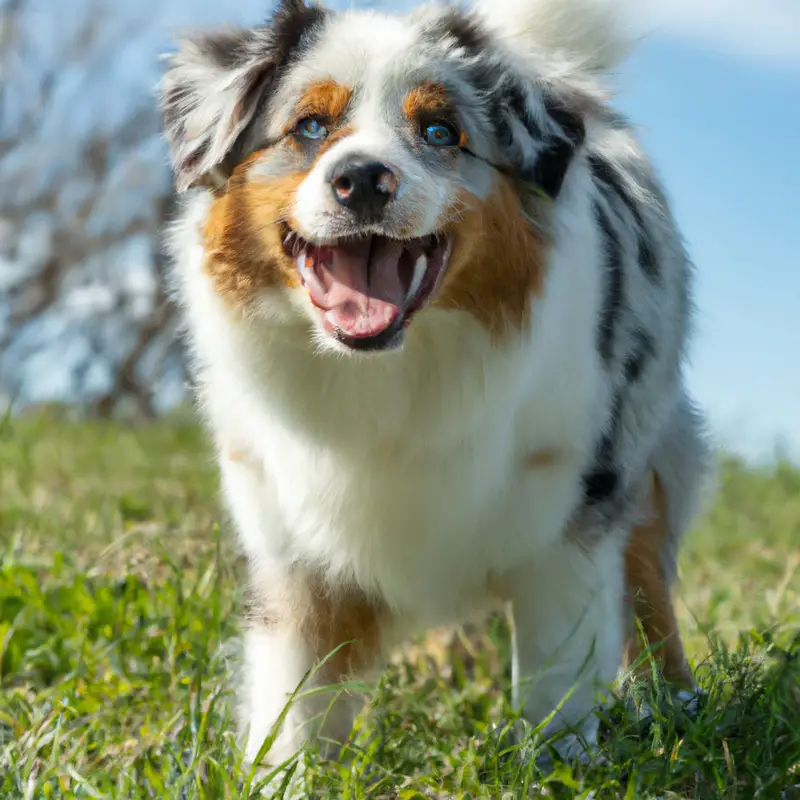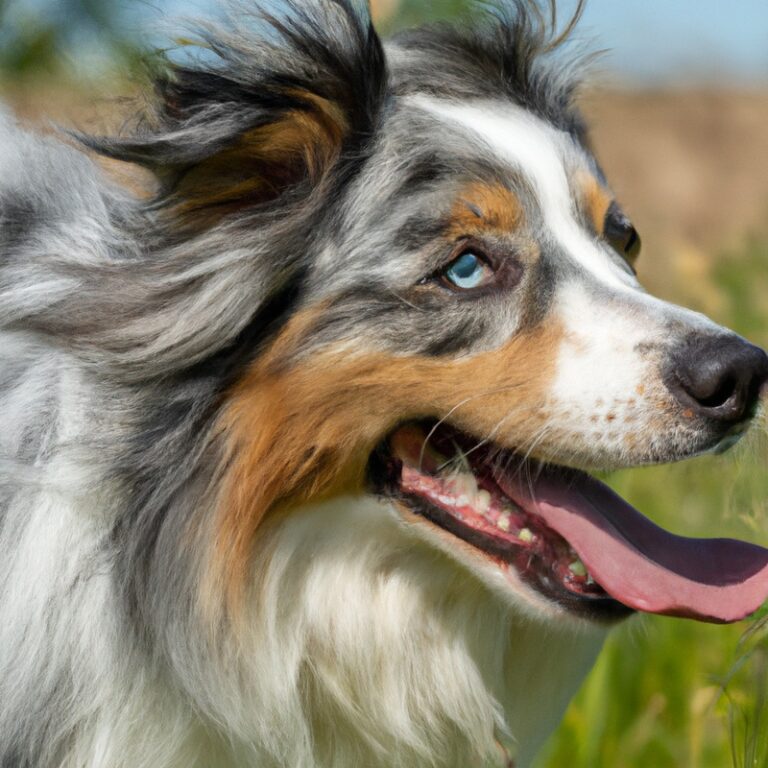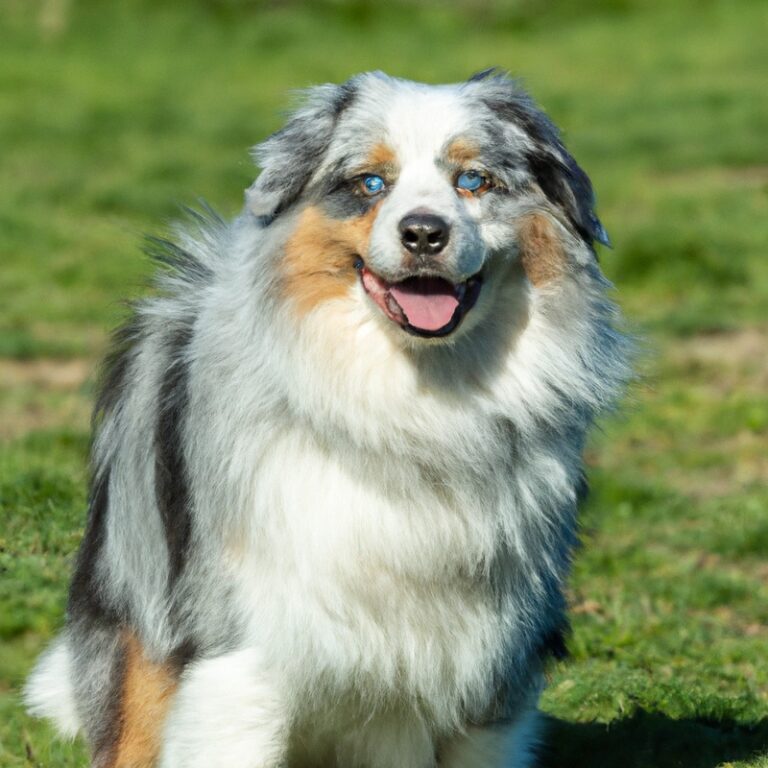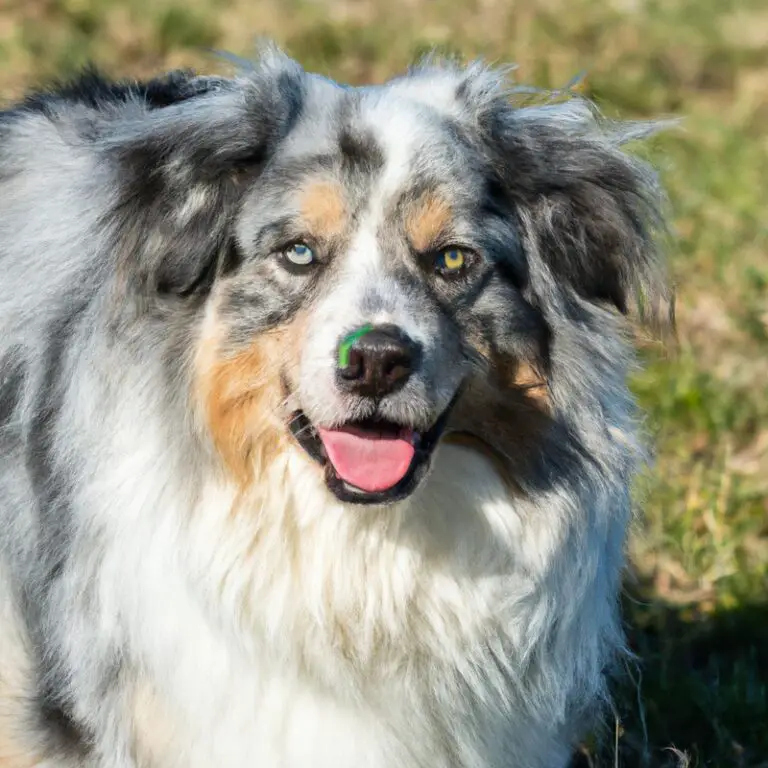How Do Australian Shepherds Behave When Introduced To New Puppies?
Key Takeaways:
- Australian Shepherds generally exhibit positive behavior when introduced to new puppies.
- They are known for being adaptable and accepting of new additions to the family.
- Proper socialization and gradual introductions are key to ensuring a successful transition for both the Australian Shepherd and the new puppies.
- With proper training and guidance, Australian Shepherds can become nurturing and protective towards new puppies.
Have you ever wondered how Australian Shepherds behave when introduced to new puppies? As an expert in canine behavior, I’ve witnessed countless interactions between Australian Shepherds and their adorable furry counterparts.
In this blog, I’ll guide you through the process of introducing these two furry friends and help you understand the fascinating behavior patterns of Australian Shepherds.
From creating a safe space to handling common challenges, I’ll provide you with invaluable insights and practical tips to ensure a harmonious and happy environment for your canine companions. So, let’s dive in and unravel the secrets of this intriguing dog breed!
| Behavior | Description |
| Curiosity | Australian Shepherds are generally curious and inquisitive by nature. When introduced to new puppies, they may display a strong sense of curiosity and investigate the new additions to the household. |
| Playfulness | Australian Shepherds are known for their playful nature. They may engage in playful behavior with the new puppies, such as chasing, nipping, and wrestling, as a way to establish a social bond. |
| Protectiveness | Some Australian Shepherds may exhibit protectiveness towards the new puppies, especially if they perceive them as part of their family or pack. They may closely monitor the puppies and intervene if they sense any potential threats. |
| Teaching | Australian Shepherds are often regarded as intelligent and trainable dogs. When introduced to new puppies, they may take on a teaching role, guiding the puppies through various social interactions and helping them learn appropriate behavior. |
| Affection | Australian Shepherds are typically affectionate dogs. They may show love and affection towards the new puppies by grooming, cuddling, or sharing sleeping spaces, which can facilitate bonding and create a positive relationship between them. |
Understanding the Australian Shepherd Behavior
Overview of the Australian Shepherd breed
The Australian Shepherd is a highly intelligent and versatile breed. They are known for their herding instincts and ability to complete tasks diligently.
They are medium-sized dogs with a well-muscled body and a medium-length coat that comes in various colors and patterns.
Australian Shepherds are active and energetic, requiring regular physical and mental stimulation to prevent boredom and destructive behavior. They excel in various activities such as obedience training, agility, and herding trials.
This breed is highly loyal and protective, making them excellent family companions.
They are generally good with children and other pets, but early socialization is essential to ensure they develop the right behavior around others. Australian Shepherds are known for their strong work ethic and their eagerness to please their owners.
They are quick learners and respond well to positive reinforcement-based training methods.
Although they are a loving and devoted breed, Australian Shepherds can sometimes exhibit herding instincts by nipping at heels or running in circles. This behavior can be managed through consistent training and redirection towards appropriate activities.
Overall, the Australian Shepherd is an active, intelligent, and loyal breed that thrives in an environment where they receive proper mental and physical stimulation.
They make excellent working dogs, companions, and family pets with the right training and socialization.
Traits and characteristics of Australian Shepherds
Australian Shepherds possess several distinctive traits and characteristics that make them stand out. Firstly, they are known for being highly intelligent and eager to learn.
This makes training them relatively easy and enjoyable.
Secondly, Australian Shepherds are known for their high energy levels. They are an active breed that requires plenty of exercise and mental stimulation to prevent boredom and destructive behavior.
Thirdly, these dogs are incredibly loyal and protective of their families.
They form strong bonds with their owners and are often wary of strangers. Additionally, Australian Shepherds have a strong herding instinct, and may try to herd people or other animals in their environment.
Another characteristic is their versatility.
They excel in various activities such as obedience, agility, herding, and even search and rescue work. Lastly, Australian Shepherds have a beautiful and distinctive coat that requires regular grooming to keep it clean and free from matting.
Overall, these traits and characteristics make Australian Shepherds a wonderful choice for an active and dedicated owner.

Common behavior patterns in Australian Shepherds
Australian Shepherds exhibit several common behavior patterns. They are highly intelligent and energetic dogs that require plenty of mental and physical stimulation.
Australian Shepherds are known for their herding instincts and may display herding behaviors, such as nipping or chasing.
They are also extremely active and require regular exercise and mental challenges to prevent boredom and destructive behaviors. Additionally, Australian Shepherds are loyal and protective of their families.
They may be wary of strangers and have a tendency to bark to alert their owners of potential threats.
Socialization from an early age is important to ensure they are well-behaved around unfamiliar people and animals. Australian Shepherds are also known for their strong desire to please their owners, making them highly trainable.
They excel in obedience, agility, and other dog sports.
However, without proper training and mental stimulation, they may become bored and resort to undesirable behaviors, such as excessive barking or digging. Lastly, Australian Shepherds are known for their intense focus and high energy levels.
They thrive on having a job to do and may become restless or anxious if not given a task.
Providing them with plenty of mental and physical exercise is essential to promoting their overall well-being and preventing any behavioral issues. Overall, understanding these common behavior patterns in Australian Shepherds is crucial for providing them with the appropriate care, training, and stimulation they need to lead happy and well-adjusted lives.
Introducing Australian Shepherds to New Puppies
Preparing for the introduction
To prepare for introducing your Australian Shepherd to a new puppy, there are a few important steps you should take. Firstly, create a safe and comfortable space for both dogs to have their own area.
This will help them feel secure and reduce the chances of territorial behavior.
Secondly, make sure both dogs are up to date on their vaccinations and in good health. This is crucial to ensure the safety and well-being of both pets.
Once you have taken these steps, you can proceed with slow and supervised introductions.
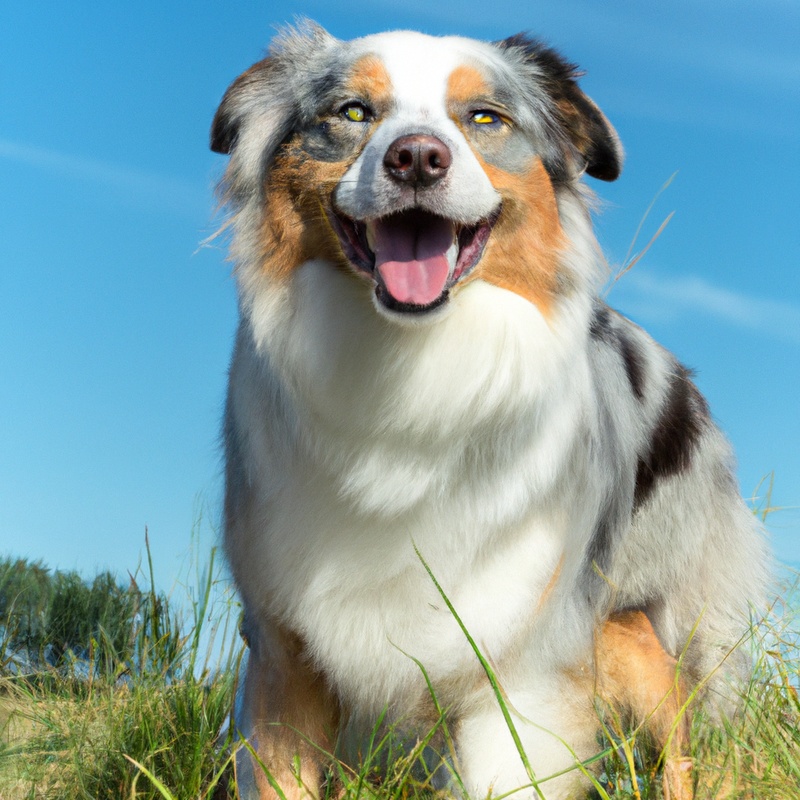
Creating a safe and comfortable space for the puppies
To create a safe and comfortable space for the puppies, it is important to ensure that their environment meets their needs. Here are some key considerations:
- Provide a designated area for the puppies: Set up a separate space for the puppies where they can have their own bed, toys, and food and water bowls. This will give them a sense of security and help establish boundaries.
- Remove potential hazards: Puppy-proof the area by removing any items that could be dangerous or toxic. Make sure electrical cords are out of reach, secure loose objects, and cover any sharp edges.
- Temperature control: Maintain a comfortable temperature in the space to prevent the puppies from getting too hot or cold. Use heating pads or blankets during colder months and ensure good ventilation during warmer months.
- Maintain cleanliness: Keep the space clean by regularly removing waste and providing fresh bedding. Puppies are more prone to accidents, so be prepared to clean up messes promptly and use puppy training pads if needed.
- Provide plenty of mental and physical stimulation: Puppies have high energy levels and need outlets for their physical and mental stimulation. Provide them with toys, puzzles, and interactive games to keep them engaged and prevent boredom.
- Create a quiet and calm environment: Puppies need a quiet and calm environment to rest and recharge. Minimize loud noises or sudden disruptions in their space to ensure they can relax and sleep peacefully.
By creating a safe and comfortable space for the puppies, you are setting them up for a positive and stress-free introduction to their new home. Remember, their well-being and happiness should always be a top priority.
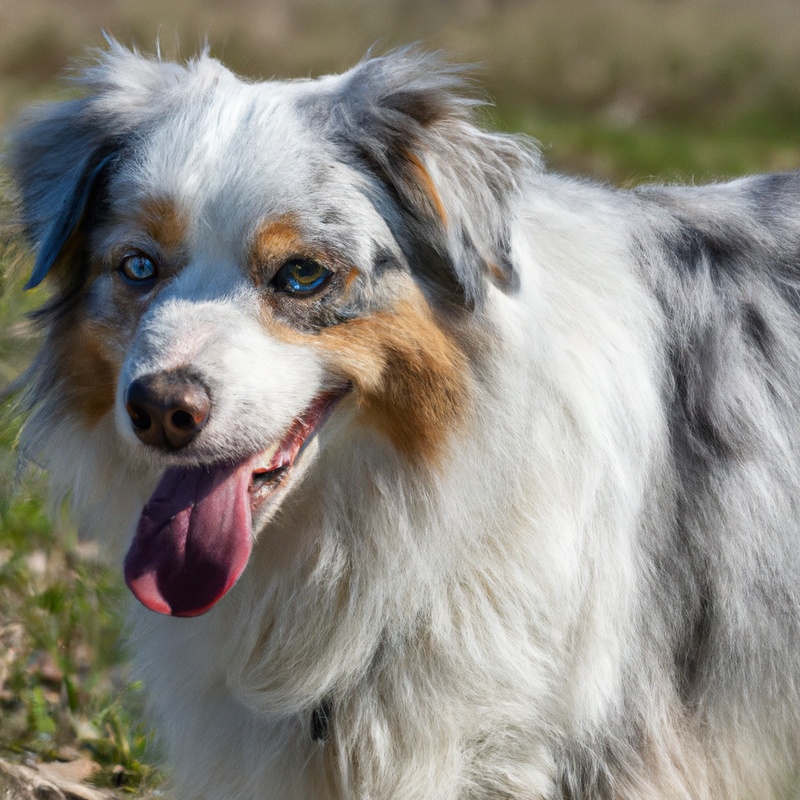
Ensuring the health and vaccinations of both dogs
Ensuring the health and vaccinations of both dogs is vital when introducing Australian Shepherds to new puppies. It ensures the safety and well-being of both dogs during their interactions.
I recommend that before introducing them, make sure both dogs are up to date on their vaccinations, including core vaccines for diseases like distemper and parvovirus.
Also, consider having them checked by a veterinarian to confirm their overall health. This helps prevent the transmission of any potential illnesses between the dogs.
Remember, a healthy start sets the foundation for a positive and successful introduction.
Slow and supervised introductions
When introducing Australian Shepherds to new puppies, it’s important to take things slow and supervise their interactions. Start by allowing the dogs to smell each other’s scents before the actual meeting.
Then, choose a neutral territory for their first encounter, such as a park or backyard.
Monitor their body language and behavior closely to ensure that they are comfortable with each other. It’s important to establish routines and boundaries, and provide supervised play and structured activities.
If any challenges arise, such as possessiveness or dominance issues, address them promptly.
Properly introducing the scents of the puppies
When introducing new puppies to your Australian Shepherd, properly introducing their scents is essential. This helps your adult dog become familiar with the puppies’ smell before they meet face to face.
So how can you do it?
You can start by rubbing a soft cloth on the puppies’ fur or bedding and then placing it in an area where your Australian Shepherd can explore and smell it. This allows your dog to get used to the scent of the puppies in a controlled and safe manner.
Remember, a gradual and supervised introduction is key to a successful transition.
Using a neutral territory for the first meeting
Using a neutral territory for the first meeting is important when introducing Australian Shepherds to new puppies. It helps create a fair and balanced environment for both dogs.
It can be a park, a friend’s backyard, or any place unfamiliar to both dogs.
This helps prevent territorial issues and allows the dogs to interact on neutral ground. It’s also crucial to closely monitor their body language and behavior during the initial interactions.
By doing so, you can ensure a positive start to their relationship and reduce the chances of any negative behavior.
Monitoring body language and behavior during the initial interactions
When introducing Australian Shepherds to new puppies, it is essential to monitor their body language and behavior during the initial interactions. This helps ensure a safe and positive experience for both dogs.
I recommend observing how they approach each other, their postures, and any signs of discomfort or aggression.
Look for positive indicators such as wagging tails, playfulness, and mutual engagement. However, if you notice signs of aggression or fear, it’s important to step in and separate the dogs.
Seek professional help if needed.
Creating a harmonious environment requires careful monitoring and intervention when necessary.
Establishing routines and boundaries
When introducing Australian Shepherds to new puppies, establishing routines and boundaries is essential. The first step is to train both dogs to follow basic commands, such as sit, stay, and come.
This helps create a structured environment where they understand their roles and boundaries.
Additionally, providing supervised play and structured activities ensures that they engage in positive interactions and learn appropriate behavior. It’s important to set aside time for individual attention and quality time with each dog to avoid any feelings of jealousy or neglect.
Maintaining fair and equal treatment is crucial in establishing routines and boundaries.
Avoid favoritism or excessive attention to one dog, and make sure they have equal access to resources and boundaries. By creating a harmonious and balanced environment, Australian Shepherds can form a strong bond with new puppies and live together happily.
Remember, consistency is key in establishing routines and boundaries for a successful introduction.
Training both dogs to follow basic commands
Training both dogs to follow basic commands is essential for creating a harmonious environment and ensuring the safety of everyone involved. To achieve this, consistency and positive reinforcement are key.
Start by teaching each dog commands such as sit, stay, and come separately in a distraction-free environment.
Once they have mastered these commands individually, you can gradually introduce them to training together. Use treats or praise as rewards for good behavior and be patient as both dogs learn at their own pace.
Remember to keep training sessions short and enjoyable for both dogs to maintain their interest and motivation.
With time and practice, both dogs will become familiar with the commands and respond obediently, allowing for a smoother and more enjoyable coexistence.
Providing supervised play and structured activities
Providing supervised play and structured activities is essential when introducing Australian Shepherds to new puppies. It helps them bond and learn appropriate behavior.
During play, closely monitor their interactions to ensure safety and prevent any aggressive behavior.
Engage them in structured activities like obedience training and puzzle toys to stimulate their minds and teach them discipline. Creating a positive and controlled environment through supervised play and structured activities sets the foundation for a harmonious relationship between the dogs.
Handling common challenges
Handling common challenges when introducing Australian Shepherds to new puppies requires patience and understanding. Two common challenges that may arise are possessiveness and resource guarding, as well as dominance and hierarchy issues.
To address possessiveness and resource guarding, it’s important to ensure that both dogs have their own space and resources.
This can be done by providing separate food bowls, toys, and sleeping areas. Teaching the Australian Shepherd to share through positive reinforcement training is also crucial.
Dominance and hierarchy issues can be managed by establishing clear boundaries and enforcing consistent rules.
Training both dogs to follow basic commands and rewarding them for respectful behavior can help establish a balanced dynamic between them. It’s also important to monitor their interactions closely and intervene if any signs of aggression or conflict arise.
Another common challenge is managing jealousy and attention-seeking behaviors.
It’s important to give both dogs equal attention and affection to avoid favoritism. Engaging in joint activities and training sessions can help foster a sense of togetherness.
Additionally, providing structured playtime and socialization opportunities can help alleviate feelings of jealousy.
Remember, every dog is different, and it may take time for them to adjust to each other. Seeking professional help from a dog behaviorist or trainer is always an option if the challenges persist.
Patience, consistency, and positive reinforcement will go a long way in creating a harmonious and happy environment for both your Australian Shepherd and new puppy.
Dealing with possessiveness and resource guarding
When dealing with possessiveness and resource guarding in Australian Shepherds, it’s important to take a proactive approach. Here are a few steps you can take:
- Establish clear boundaries and rules: Train your Australian Shepherd to understand that resources, such as food bowls and toys, belong to you and must be shared. Use positive reinforcement techniques to reward good behavior.
- Gradually introduce new items or puppies: If your Australian Shepherd shows possessive behavior towards a new item or a new puppy, introduce it gradually and in controlled settings. Start by allowing them to sniff and observe from a distance, rewarding calm behavior.
- Implement a “trading” system: Teach your Australian Shepherd that giving up an item or resource leads to something equally valuable. Use treats or toys as rewards when they willingly let go of an object.
- Keep a calm and assertive demeanor: Your energy and behavior influence your dog’s behavior. Stay calm and assertive during interactions, avoiding tense or confrontational situations that may increase possessiveness.
- Seek professional help if necessary: If the possessiveness and resource guarding behaviors persist or escalate, consider consulting a professional dog behaviorist or trainer. They can provide guidance and tailored strategies to address these specific behaviors.
Remember, consistency and patience are key when dealing with possessiveness and resource guarding. By implementing these steps and seeking professional help if needed, you can help your Australian Shepherd overcome these challenges and create a harmonious environment for both dogs.
Addressing dominance and hierarchy issues
Addressing dominance and hierarchy issues when introducing Australian Shepherds to new puppies is crucial for a harmonious relationship. I have found that setting clear boundaries and establishing a consistent hierarchy helps in reducing conflicts.
It’s important to provide equal attention and resources to both dogs, avoiding favoritism.
Additionally, proper training and socialization can help in minimizing dominance-related behaviors. If there are persistent issues, seeking guidance from a professional dog trainer or behaviorist can be beneficial.
Remember, addressing dominance and hierarchy issues early on can create a balanced and peaceful environment for all dogs involved.
Managing jealousy and attention-seeking behaviors
Managing jealousy and attention-seeking behaviors in Australian Shepherds can be challenging but not impossible. Here are a few tips to help you navigate this situation:
- Provide equal attention: Make sure to spend quality time with both your Australian Shepherd and the new puppy. By giving them equal attention, you can minimize any feelings of jealousy.
- Set clear boundaries: Establishing rules and boundaries for both dogs will help them understand their place in the pack and reduce any competition for attention. Consistency is key.
- Reward positive behavior: Whenever your Australian Shepherd displays non-jealous or attention-seeking behaviors, reward them with treats or praise. This will reinforce those behaviors and encourage more of them.
- Encourage independence: Help your Australian Shepherd develop an independent and confident mindset by providing them with toys, puzzles, and activities that they can enjoy on their own.
- Training and mental stimulation: Keep your Australian Shepherd engaged and mentally stimulated through regular training sessions and interactive games. This will divert their attention away from seeking attention and focus their energy on learning.
Remember, each dog is unique, and it may take time for your Australian Shepherd to adjust to the new puppy. Patience, consistency, and positive reinforcement are key in managing jealousy and attention-seeking behaviors.
Signs of Good Behavior during the Introduction
Positive body language and interaction
Positive body language and interaction is a key indicator of a good introduction between Australian Shepherds and new puppies. Here are some signs to look out for:
- Playful behavior and mutual engagement: When the Australian Shepherd and the puppy engage in playful activities, it shows that they are comfortable and enjoying each other’s company. They may chase each other, wrestle, or play with toys together.
- Respectful and adaptable response to each other: If the Australian Shepherd shows respect towards the puppy’s space and boundaries, it demonstrates a positive interaction. They may take turns interacting or allow the puppy to approach them without any signs of discomfort or aggression.
- Sharing and taking turns without aggression: When both dogs can share resources such as toys, treats, or attention without any signs of possessiveness or aggression, it indicates a healthy and positive relationship. They may willingly give up a toy or take turns playing with it.
It’s important to note that positive body language and interaction might take time to develop. During the introduction period, observe the dogs for gradual improvements in their comfort level:
- Reduced tension and stress over time: As the dogs spend more time together, look for a decrease in tension and stress signals such as stiff body posture, raised hair on the back, or excessive vocalization. A more relaxed demeanor indicates a growing level of comfort.
- Increased curiosity and exploration between the dogs: If the Australian Shepherd and the puppy become more curious about each other and willingly explore each other’s presence, it signals a positive shift in their relationship. They may sniff each other, playfully investigate, or follow each other around.
- Growing bond and bond-building activities: As the introduction progresses, you may notice the Australian Shepherd and the puppy engaging in activities that help build a bond between them. This could include grooming each other, sleeping in close proximity, or seeking each other out for comfort or play.
Remember, every dog is unique, and the pace at which positive body language and interaction develop can vary. Be patient and provide a safe and supportive environment for the Australian Shepherd and the new puppy to foster a healthy relationship.
Playful behavior and mutual engagement
Playful behavior and mutual engagement during the introduction of Australian Shepherds to new puppies is a positive sign. It indicates that both dogs are comfortable and interested in getting to know each other.
When Australian Shepherds exhibit playful behavior, such as play-bowing, wagging their tails, or offering toys, it shows that they are inviting the puppies to join in the fun.
This behavior creates a welcoming and friendly atmosphere between the dogs. Mutual engagement is another important aspect to look out for.
It means that both the Australian Shepherds and the puppies are actively interacting with each other, showing interest, and reciprocating each other’s gestures.
This can include chasing each other, taking turns during play, or engaging in gentle wrestling. The presence of playful behavior and mutual engagement between Australian Shepherds and new puppies indicates a positive and healthy relationship.
It shows that they are building trust, establishing a bond, and enjoying each other’s company.
By observing and encouraging this behavior, you can ensure a smooth and enjoyable introduction process between Australian Shepherds and new puppies. It is a good sign that they are on the right track to forming a harmonious and happy relationship.
Respectful and adaptable response to each other
Respectful and adaptable response to each other is crucial when introducing Australian Shepherds to new puppies. It’s important for the dogs to interact in a positive and respectful manner.
They should show playful behavior, engage with each other, and share and take turns without aggression.
Gradually, you should observe a reduction in tension and stress, an increase in curiosity and exploration, and a growing bond between the dogs. This can be achieved through supervised and structured activities, as well as by strengthening their bond through joint training sessions.
Sharing and taking turns without aggression
Sharing and taking turns without aggression is an essential behavior when introducing Australian Shepherds to new puppies. It shows that the dogs are respectful and adaptable to each other’s presence.
Good behavior in this area involves gentle play and interaction, with neither dog showing possessiveness or aggression over toys or resources.
Instead, they should be able to share and take turns willingly, without causing harm or discomfort to one another. This behavior fosters a positive and harmonious environment for both dogs, allowing them to build a strong bond and develop a healthy relationship over time.
Gradual improvement in comfort level
Gradual improvement in comfort level is an important aspect when introducing Australian Shepherds to new puppies. As they spend more time together, you should observe reduced tension and stress.
Over time, you may notice increased curiosity and exploration between the dogs, indicating a growing bond.
Engaging in bond-building activities, such as joint training sessions and supervised playtime, can further enhance their relationship. It’s essential to provide a safe and harmonious environment where they can continue to develop their comfort levels and build a positive relationship.
Reduced tension and stress over time
Reduced tension and stress over time is a positive sign when introducing Australian Shepherds to new puppies. It shows that the dogs are gradually getting comfortable with each other’s presence and are beginning to form a bond.
As the dogs spend more time together, you may notice a decrease in any initial signs of aggression or fear.
Instead, they may exhibit curiosity, exploration, and even engage in playful behavior with each other. This gradual improvement in comfort level is an important indicator that the introduction process is going well.
It is essential to continue monitoring their interactions, providing supervised play, and engaging in bond-building activities to further strengthen their relationship.
Increased curiosity and exploration between the dogs
Increased curiosity and exploration between dogs is a positive sign during their introduction. It indicates that they are beginning to feel more comfortable with each other and are interested in getting to know one another.
When dogs are curious about each other, they may approach each other with positive body language, such as wagging tails and relaxed postures.
They may also engage in play behavior, such as chasing or wrestling, which is a form of interaction that helps build their bond. As they become more familiar with each other, they may also start exploring together, sniffing around their surroundings and investigating new objects or areas.
This curiosity and exploration is a natural part of the bonding process and can lead to a stronger relationship between the dogs.
Growing bond and bond-building activities
Growing a bond with your Australian Shepherd and helping them build a strong relationship with a new puppy is an essential part of the introduction process. To foster this bond, engaging in various activities can be very beneficial.
Here are some ways to promote a growing bond between your Australian Shepherd and the new puppy:
- Joint play sessions: Encourage interactive playtime between the two dogs. This can include playing fetch, tug-of-war, or chasing each other. These activities not only provide physical exercise but also create opportunities for them to bond through play.
- Training together: Train both dogs simultaneously to establish a sense of teamwork and cooperation. Teach them basic commands such as sit, stay, and come. Training sessions can be a fun bonding experience and help them learn to work together.
- Shared walks: Take your Australian Shepherd and the new puppy for walks together. Walking side by side allows them to explore the world together and form a positive association with each other’s presence.
- Socialization activities: Exposing both dogs to different environments, people, and other animals can help them bond and build confidence. Take them to dog parks or arrange playdates with other well-behaved dogs under supervision.
- Mealtimes together: Feed and provide water to both dogs at the same time, ideally in separate bowls but in proximity to each other. Eating together can foster a sense of harmony and reinforce positive associations with each other.
- Quiet and calm time: Encourage moments of relaxation and downtime, where both dogs can rest in close proximity. This helps establish a sense of comfort and familiarity between them.
- Interactive toys: Provide toys that can be shared, such as puzzle toys or interactive treat-dispensing toys. This promotes cooperative play and encourages them to interact positively with each other.
Remember, every dog is unique, so take their individual personalities and comfort levels into account when engaging in these activities. Patience and consistency are key in building a bond between your Australian Shepherd and the new puppy.
What to Do in Case of Negative Behavior
Identifying signs of aggression or fear
When introducing Australian Shepherds to new puppies, it’s important to observe their behavior for signs of aggression or fear. Some common signs to watch out for include growling, barking, showing teeth, stiff body posture, raised hair on the back, and attempts to snap or bite the new puppy.
These behaviors indicate that the Australian Shepherd may be feeling threatened or uncomfortable.
If you notice any of these signs, it’s crucial to take immediate steps to de-escalate the tension. This includes separating the dogs and giving them space, and reintroducing them gradually and with caution.
If the negative behavior persists, seeking professional help from a dog behaviorist or trainer can be beneficial.
Growling, barking, or showing teeth
When introducing Australian Shepherds to new puppies, it is possible for them to exhibit negative behavior such as growling, barking, or showing their teeth. These behaviors are often signs of discomfort or unease.
It’s important to pay close attention to these signs and take appropriate action.
If your Australian Shepherd is growling, barking, or showing their teeth, it indicates that they may feel threatened or anxious. It’s essential to create a safe and comfortable environment for both dogs during the introduction process.
This includes providing a neutral territory for the first meeting and properly introducing the scents of the puppies beforehand.
Monitoring body language and behavior is crucial during the initial interactions. You should watch for signs of aggression or fear, such as a stiff body posture or raised hair on the back.
If any negative behavior occurs, immediately separate the dogs and give them space.
It helps to reintroduce them gradually and with caution to reduce tension. If the negative behavior persists or worsens, seeking professional help from a dog behaviorist or trainer is recommended.
They can provide guidance on behavior modification techniques and help address any underlying issues.
Remember, the goal is to create a harmonious and happy environment for both dogs to thrive in.
Stiff body posture or raised hair on the back
When a dog exhibits a stiff body posture or raised hair on its back, it is typically a sign of anxiety, fear, or aggression. This behavior may indicate that the dog is feeling threatened or uncomfortable in a particular situation.
It’s essential to pay attention to these signs and take appropriate action to ensure the safety and well-being of all animals involved.
If you notice your Australian Shepherd showing a stiff body posture or raised hair on its back when introduced to a new puppy, it’s crucial to intervene immediately. This behavior could potentially escalate into aggression, leading to a dangerous situation for both dogs.
To de-escalate the tension, separate the dogs and give them space.
Allow them to calm down and reintroduce them gradually and with caution. Seeking professional help from a dog behaviorist or trainer may also be beneficial in addressing and modifying the negative behaviors.
Remember, the goal is to create a harmonious and happy environment for both dogs.
By understanding and addressing these signs of negative behavior, you can help ensure a positive introduction and a healthy relationship between your Australian Shepherd and the new puppy.
Attempting to snap or bite the new puppy
If your Australian Shepherd attempts to snap or bite the new puppy during the introduction, it is important to take immediate action to prevent any harm. These behaviors can be a sign of aggression or fear.
Firstly, you should separate the dogs and give them some space to calm down.
Then, you can gradually reintroduce them under supervision, keeping a close eye on their body language and behavior. If the negative behavior persists or escalates, it may be necessary to seek professional help from a dog behaviorist or trainer.
They can provide guidance on behavior modification techniques to address the underlying issues causing the aggression.
Remember, the safety and well-being of both dogs should always be the top priority. With proper management and training, it is possible to create a harmonious environment where both dogs can coexist peacefully.
Immediate steps to de-escalate tension
Immediate steps to de-escalate tension between Australian Shepherds and new puppies involve separating the dogs and giving them space. It’s important to reintroduce them gradually and with caution.
If necessary, seeking professional help from a dog behaviorist or trainer can provide valuable guidance.
Remember, the key is to ensure the safety and well-being of both dogs during this transition period.
Separating the dogs and giving them space
One important step in introducing Australian Shepherds to new puppies is separating the dogs and giving them space. This allows them to become comfortable in their own areas and reduces the potential for conflict or stress.
By providing separate spaces, such as crates or separate rooms, each dog can have their own safe haven.
This allows them to relax and adjust to the new presence without feeling overwhelmed. Giving them space also helps prevent any unwanted behaviors that may arise from feeling crowded or territorial.
Reintroducing them gradually and with caution
When reintroducing Australian Shepherds to new puppies, it’s important to take it slow and be cautious. Gradual reintroduction allows the dogs to get used to each other without feeling overwhelmed.
Start by giving them separate spaces and gradually allow them to spend more time together under supervision.
Watch their body language and behavior closely to ensure they are comfortable and not showing any signs of aggression. If any negative behavior arises, separate them again and try reintroducing them at a later time.
Seek professional help if necessary.
Seeking professional help if necessary
If you’re having difficulties introducing your Australian Shepherd to a new puppy and the behavior is becoming concerning or aggressive, it may be necessary to seek professional help. Consulting with a dog behaviorist or trainer who specializes in working with Australian Shepherds can provide valuable guidance and support.
They can assess the situation, provide expert advice, and offer behavior modification techniques to address the negative behavior.
Remember, seeking professional help can make a significant difference in creating a harmonious and happy environment for both your Australian Shepherd and the new puppy.
Consulting a dog behaviorist or trainer
Consulting a dog behaviorist or trainer is highly recommended if you’re experiencing challenges when introducing your Australian Shepherd to a new puppy. These professionals have the expertise and knowledge to assess the situation, identify the underlying issues, and provide guidance on how to address them effectively.
They can help you understand your dog’s behavior, offer training techniques, and develop a customized plan to ensure a harmonious relationship between your dogs.
Seeking professional help can make a significant difference in creating a positive environment for both dogs and fostering a successful introduction.
Exploring behavior modification techniques
When it comes to modifying behavior in Australian Shepherds, there are effective techniques you can try. One approach is positive reinforcement training, which involves rewarding good behavior with treats or praise.
This helps to reinforce desired behaviors and discourage undesirable ones.
Another technique is redirection, where you redirect your dog’s attention to a more appropriate behavior when they engage in unwanted behavior. For example, if your dog starts chewing on furniture, you can redirect them to a chew toy instead.
Consistency is key in behavior modification, so be patient and persistent with your training efforts.
Remember to seek assistance from a professional dog trainer if you encounter any challenges along the way.
Creating a Harmonious and Happy Environment
Strengthening the bond between the dogs
To strengthen the bond between your dogs, it’s important to engage in joint activities with them. This could include going for walks or hikes together, playing interactive games, or participating in training sessions as a group.
Allowing supervised playtime and socialization can also help them build a positive relationship.
It’s crucial to establish a structured routine that includes consistent feeding schedules, potty breaks, and individual attention for each dog. Avoid favoritism or excessive attention to one dog, and make sure both dogs have equal access to resources and boundaries.
Engaging in joint activities and training sessions
Engaging in joint activities and training sessions is a great way to build a strong bond between Australian Shepherds and new puppies. One activity that can be beneficial is going on walks together.
This allows them to explore their surroundings, bond, and learn to walk side by side.
Another activity is playing interactive games like fetch or hide-and-seek. This helps them burn off energy and have fun together.
Training sessions are also important for establishing communication and obedience.
Teaching basic commands like sit, stay, and come can be done individually and then practiced together. This helps them learn to listen and respond to commands in a group setting.
Training sessions can also include mental stimulation activities, like puzzle toys or obedience challenges, to keep their minds sharp and engaged.
It’s essential to supervise and guide their interactions during joint activities and training sessions. Observe their body language and step in if any signs of discomfort or aggression are displayed.
Positive reinforcement techniques, such as treats and praise, should be used consistently to reward good behavior.
This will encourage both the Australian Shepherd and the new puppy to engage and cooperate. By engaging in joint activities and training sessions, Australian Shepherds and puppies can develop a positive relationship, improve their obedience skills, and have a lot of fun together.
Remember to make sure the activities and training are suitable for their age and energy levels.
Allowing supervised playtime and socialization
Allowing supervised playtime and socialization is essential for Australian Shepherds when introducing them to new puppies. It helps them build positive relationships and social skills.
During playtime, I make sure to closely monitor their interactions to prevent any aggression or dominance issues.
I also ensure that both dogs have equal opportunities to engage in play and that they take turns without showing any possessiveness or resource guarding behaviors. This supervised playtime and socialization not only helps them bond but also promotes a harmonious and happy environment for both dogs.
Consistent feeding schedules and potty breaks
Consistent feeding schedules and potty breaks are essential for creating a harmonious and happy environment for your Australian Shepherd and the new puppy. Regular and timely meals help establish a routine and provide a sense of security for both dogs.
It is important to feed them at the same time every day to avoid any conflicts or competition over food.
Additionally, consistent potty breaks ensure that both dogs have ample opportunities to relieve themselves and minimize accidents indoors. By adhering to a schedule, you can establish good habits and create a structured routine for your furry companions.
Providing individual attention and quality time
Providing individual attention and quality time is essential when introducing Australian Shepherds to new puppies. It is important to give each dog equal amounts of attention and affection.
Spend time playing, training, and engaging with both dogs separately, ensuring they feel loved and valued.
This helps build a strong bond and prevents any feelings of jealousy or rivalry. Additionally, regular one-on-one activities and outings can help establish a special connection with each dog, promoting a harmonious and happy environment in your home.
Maintaining fair and equal treatment
Maintaining fair and equal treatment is essential when introducing Australian Shepherds to new puppies. To ensure harmony, it’s important to avoid favoritism or excessive attention towards one dog.
You should provide equal access to resources and establish clear boundaries for both dogs.
This includes giving them the same amount of affection, playtime, and training opportunities. By treating both dogs fairly and equally, you can create a balanced and happy environment for everyone involved.
Avoiding favoritism or excessive attention to one dog
When introducing new puppies to your Australian Shepherds, it is essential to avoid favoritism or giving excessive attention to one dog. This can create imbalance and resentment between the dogs.
Treat both dogs equally and provide them with equal amounts of love, care, and attention.
Avoid showing preference towards one dog and ensure that both receive individual attention and quality time. Additionally, make sure that both dogs have equal access to resources, such as food, toys, and sleeping areas.
This will help create a harmonious and happy environment for both dogs to thrive in.
Ensuring equal access to resources and boundaries
When introducing new puppies to your Australian Shepherd, it’s important to ensure equal access to resources and boundaries for both dogs. This means providing separate food and water bowls, toys, and resting areas to avoid any potential conflicts over possessions.
Additionally, establish clear boundaries and rules for both dogs to follow, such as no jumping on furniture or no stealing each other’s toys.
By doing so, you can create a fair and harmonious environment where both dogs feel respected and secure.
Final Verdict
Introducing Australian Shepherds to new puppies requires careful preparation, supervision, and patience. Creating a safe environment, properly introducing scents, and monitoring body language are essential steps.
Establishing routines and boundaries, addressing common challenges, and promoting positive interactions are key to a harmonious introduction.
Positive signs include playful behavior, adaptability, and sharing without aggression. However, if negative behaviors arise, immediate steps should be taken to de-escalate tension and seeking professional help if necessary.
By creating a harmonious and happy environment, strengthening the bond between the dogs, and maintaining fair treatment, a successful introduction can be achieved.

